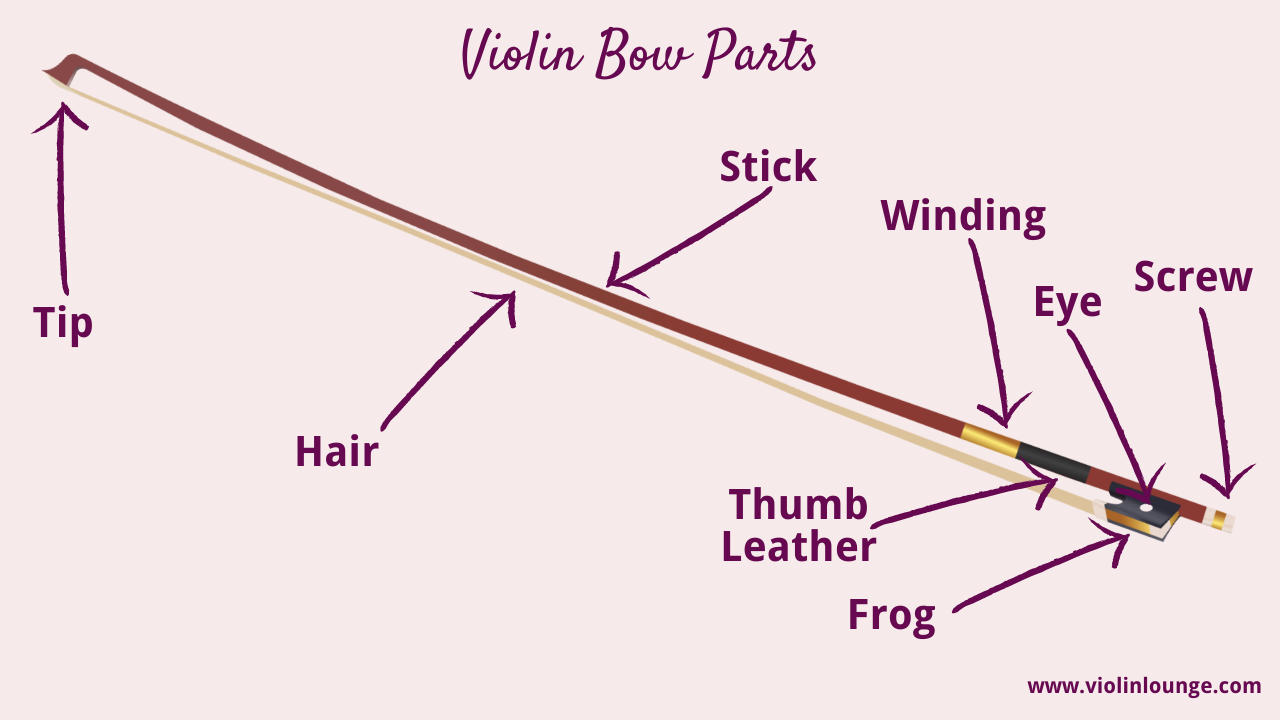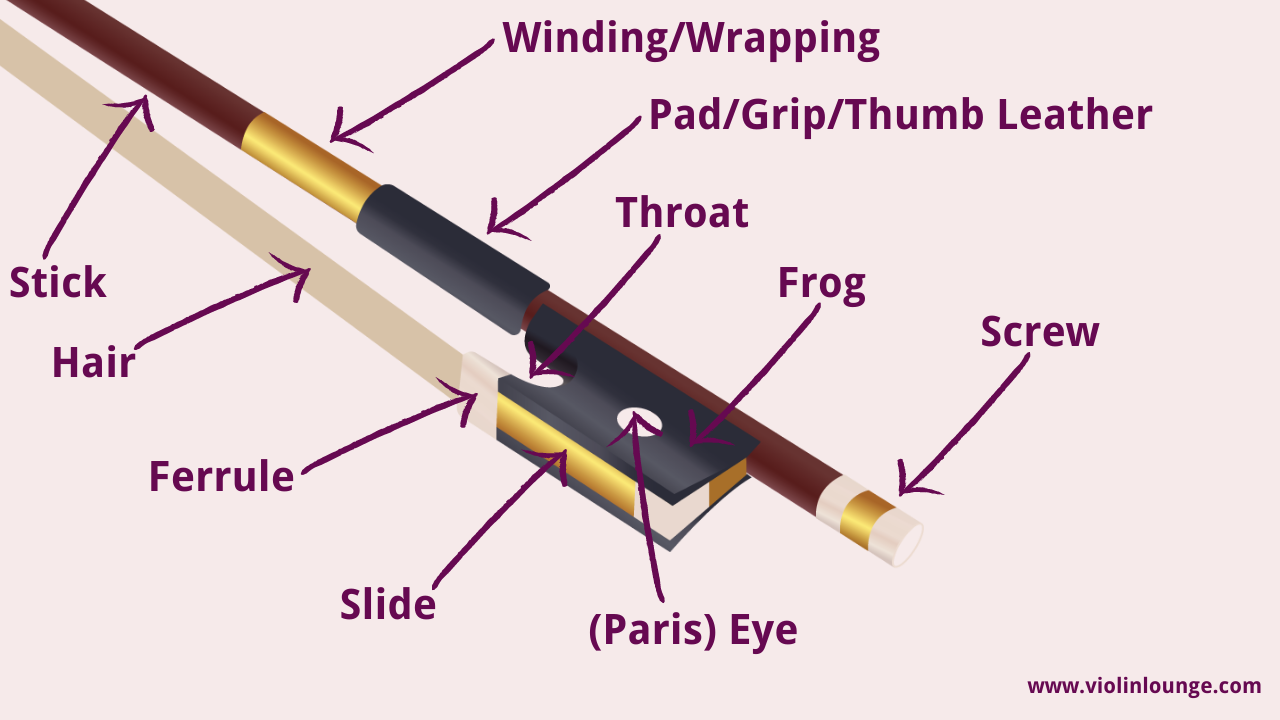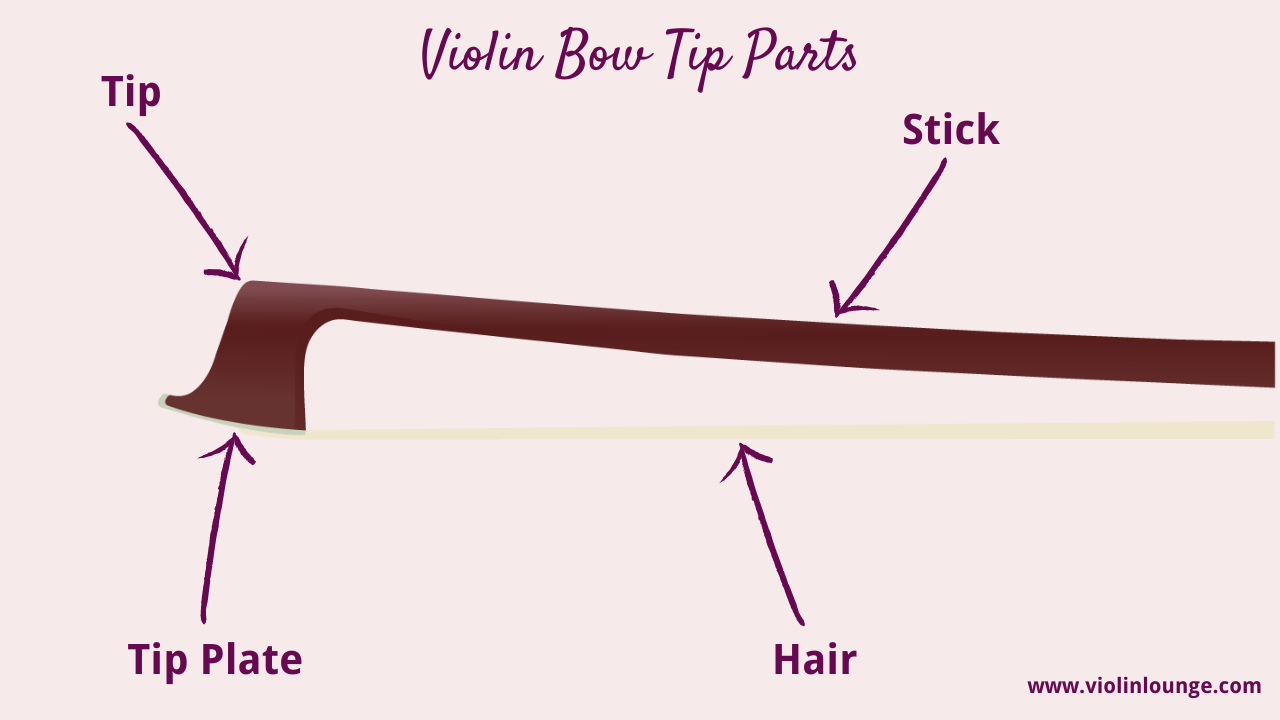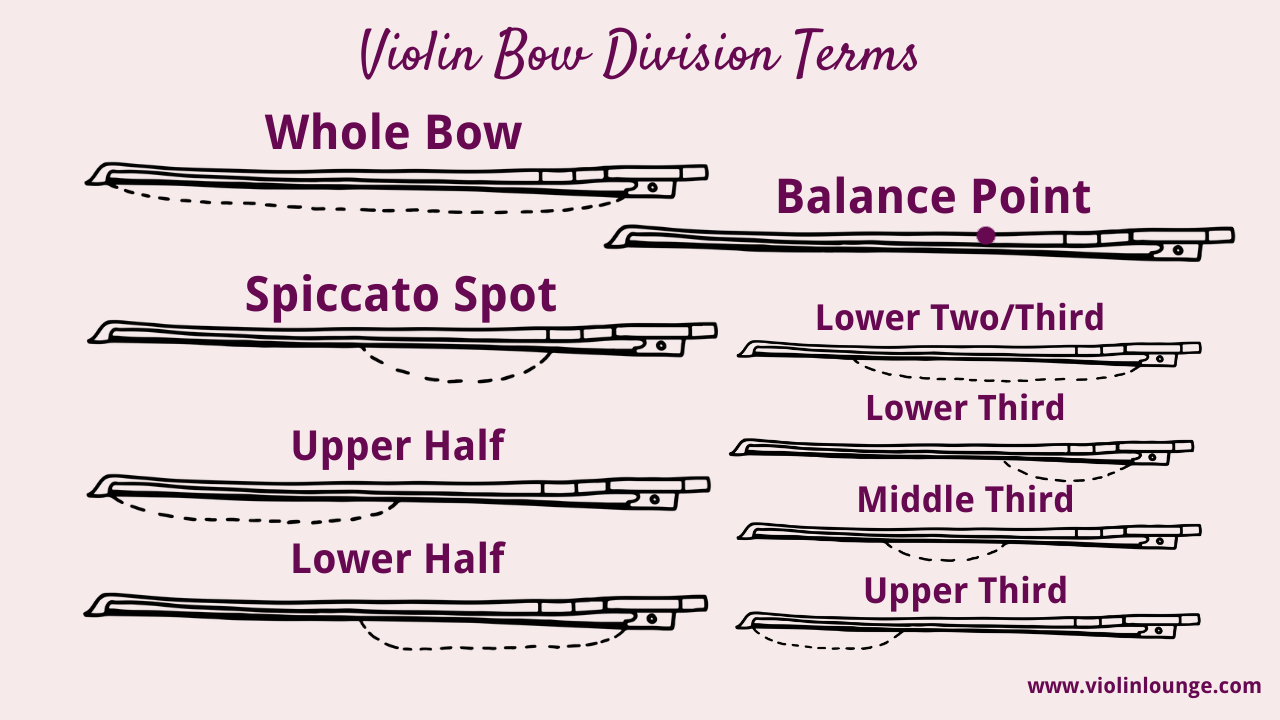Violin Bow Parts: anatomy, function and bow division
Parts of the violin explained: frog, tip, screw, stick, hair, winding etc.
Also we’ll cover which part of the violin to play: upper half, at the frog, spiccato spot etc
In this article, I’ll not only discuss the parts of the violin bow, including its physical characteristics. I’ll also explain parts of the violin bow as referenced for bow division, the optimal bow placement and bow usage for common bow strokes, and how to use the bow to create dynamics.
First we’ll go through all the different parts of the violin bow and their function. After that I’ll cover the terms you see in sheet music, like at the frog and upper half. Also we’ll go through on which part of the violin bow hair we play different violin bowing techniques.
Overview of the violin bow parts

The violin bow is used to draw the sound out of the violin
Violin Bow Stick
The stick of the bow is most often made out of either wood or carbon fiber, and it’s function is to hold the hair of the bow in place. Bow sticks should always maintain a convex (downward) curve. If the stick is straight across or curving outwards, the bow is too tight and needs to be loosened.
Violin Bow Hair
The bow hair is generally made out of horse hair. The hair is used to glide across the strings, thus making the strings vibrate and create a sound. Avoid touching the hair as much as possible to protect it from harmful oils found in your skin, which will “slicken” the hair and cause it not to grab the strings as well, thus leading to the need for a rehair.
Rehair your Violin Bow
A rehair is when you take your bow to the luthier and have them swap out your old bow hair for new, clean horse hair. This should be done every 6 months to several years, depending on how much you play and how intensively you play. You’ve probably seen videos of soloists where the horse hair flies around during a concert. They may need a rehair pretty soon!
Help! My violin bow doesn’t make sound…
If you get your bow back from the luthier and it doesn’t seem to make a sound, apply a hefty coat of rosin to the bow. This goes also for new violin bows.
Also make sure you have good quality rosin. If you bought a really cheap violin online, the rosin might not be functional. I personally use Pirastro Evah Pirazzi Gold rosin and highly recommend it.
Myth: the horse hair has little hooks
There’s myth even seasoned violin players and teachers still believe: the horse hair should contain little hooks that draw the sound of the violin.
If you look at violin bow hair under a microscope you’ll see that the hair is absolutely smooth.
We know the hooks are a myth, because without rosin a violin bow can’t draw sound out of the violin.
It’s the rosin that makes the horse hair sticky. It can ‘pull’ the strings and make a continuous sound while bowing on the violin.
Money saver: don't rehair your bow too soon
However, maybe the violin bow hair is fine, but it’s just dirty. In that case you can clean your violin bow like I show in this video. It’s easy to do at home.
When the hair is really worn down and the violin bow has lost some hairs, then it’s really time for a rehair.
Frog and Tip
Violin Bow Frog Parts
The handle of the violin bow is called the frog. Here’s an overview with all the parts you find in the lower half of the bow:

Violin Bow Tip Parts
The end of the violin bow is called the tip. Here’s a detailed image of the violin bow tip. The tip plate can be of nickel, silver, ivory or gold.

The tip is located at the uppermost point of the bow, and it usually has a curved, pointed shape. The hair is attached to the stick at the tip through the tip plate. Be careful with where you wave your tip, as it is quite easy to damage. I once hit the tip of my bow on a music stand and the point fell off!
The frog lies on the opposite end of the bow, at the bottom, is made of ebony (a dark-colored wood from a tropical climate tree), and is used to house the mechanism that tightens and loosens the bow.
The frog is comprised of many smaller parts, including the ferrule, side, eye, and throat
The ferrule is a removable plate of metal used to protect the place where the hair attaches to the frog. Although the ferrule can be removed in order to change the bow hair, do not try to remove it yourself! Take it to a trusted luthier.
The side of the frog is the portion that lies directly underneath the ferrule. The side can either be made of ebony or in some cases, mother of pearl, which gives it a more decorative look.
The eye of the frog is another ornamental part of the bow; it is the circle on the side of the frog. Not all bows have an eye, so if yours doesn’t, don’t worry! It is just there for decoration.
The throat of the bow is the curved portion of the frog, directly across from the ferrule. Most players place their thumb in or directly above the throat.
At the very bottom of the bow lies the metal screw, which is used to tighten and loosen the bow hair.
How to tighten your violin bow hair?
Before playing, turn the screw to the right to tighten the bow hair. It should be tight enough for a pencil to fit through at its smallest point (around the middle of the bow). Before putting the violin away for the day, turn the screw to the left to loosen the bow hair. It shouldn’t be so loose that the hair becomes stringy. To remember which way to turn the screw, I like to say the phrase ‘righty tighty lefty loosy.’ The reason we loosen the bow hair is to help the hair maintain its tension.
Above the frog lies the grip (or pad), which is most often made out of leather, which is why some call it thumb leather. The grip helps the player maintain solid contact with the bow, especially when their hands get sweaty!
The winding (or lapping) is the wrapping located right above the grip. The winding helps add a bit of weight to the bow which in turn adjusts the balance point. The winding can be made out of a variety of materials, including wire (nickel, silver, gold), faux whalebone, and silk. The winding can look very different for different violin bows and the silk can have a variety of colors.
My teacher said to play in the upper half! What does that mean?
Great question! We have covered the physical make-up of the violin, but now we will dive into bow division, which tells us what part of and how much bow to use for certain bow strokes and for creating dynamics.
Bow Division
What part of the violin bow to use when bowing?
We bow with the hair, but it makes a lot of difference which part of the hair you use: the whole bow, upper half, at the frog, spiccato spot…
You can see the bow hair and the bow division while bowing as the breath of a singer. It’s crucial to play music well and is a tool of expression.
Violin Bow Division Terms Overview
Here are the violin bow parts that might be mentioned by your teacher:

The upper half is the top half of the bow, nearest to the tip.
The middle is the exact middle part of the bow, about 2 inches in length.
The lower middle is the portion of the bow halfway between the middle and the frog, near the balance point.
The balance point is the place on the bow where each side of the bow weighs the same. The exact spot of the balance point varies from bow to bow, but you can find it by trying to balance the bow on your index finger. If you’ve found the proper balance point, the bow should be able to balance on your finger without help from your other hand.
The lower half is the bottom half of the bow, between the middle and the frog.
The frog is the lowermost part of the bow, near the winding, grip, and ferrule. This is usually the hardest part of the bow to play in because it is much heavier than the rest, and therefore requires a lot of counterbalance with the pinky (pinky strength, anyone?!)
The whole bow is the entire length of the bow from frog to tip.
But how do I know which part of the violin bow to use?!
That’s a great question! To easily figure out which part of the bow to use, remember my six rules of bow division.
6 rules of bow division
- The length of the bow is the length of the note. This means that longer notes like half and whole notes get more bow, and shorter notes like eighth and sixteenth notes get less bow.
- Use more bow for louder notes and less bow for softer notes. This is the easiest way to create dynamics.
- Play on the string bow techniques on the upper half and bouncing bow techniques on the lower half or in the middle of the bow.
- The faster the bounce, the higher up the bow you play (until the middle). The slower the bounce, the closer to the frog you play. When the bow bounce is slower, it requires more control, which is easier near the frog.
- The least active bowing technique determines the place on the bow. Least active simply means that instead of you doing the work, the bow does the work for you!
- The least active bowing technique determines the length of the bow strokes. Passive bow strokes generally use small amounts of bow.
Are you thinking ‘huh, active and passive bow technique? What’s this all about?’ Read all about different violin bowing techniques and terms right here.
Improve your violin bowing technique
Enjoy my FREE mini Masterclass 5 Bowing Secrets to Create a Professional Sound on the Violin
Bow Stroke Guide
Where on the bow should I perform different violin bowing techniques?
Below, I’ve listed 14 standard bow strokes with their optimal bow placement.
Detaché is the most basic violin bow stroke, implying separate, smooth bows. Detaché can be done in any place on the bow and with any amount of bow.
Staccato is simply stopping the bow between each note. This creates a slight space or separation between each bow stroke. Staccato can be done in any place on the bow and with any amount of bow, but is most commonly done in the middle or lower middle with small amounts of bow.
Slurred Staccato is a series of many short, staccato notes in a row on one bow. This can be done with any amount of bow and in any part of the bow. For fast slurred staccato, I find it easiest to perform in the upper half of the bow.
Legato is when two or more notes are slurred, or played on the same bow. Slurs can be done in any place on the bow and with any amount of bow.
Martelé is used to create accents (martelé literally means “hammered” in Italian!). To perform martelé, press the bow into the string with you index finger, and then instantaneously release the pressure as you draw the bow. This technique creates an accent followed by a beautiful ringing tone. Martelé can be done in any place on the bow and with any amount of bow.
Brush Stroke is done when the player actively bounces the bow off of the string in between each bow stroke. This should be performed in the lower half of the bow, and with just about an inch or two of bow.
Spiccato is when the bow passively bounces off the string between each note. Passively means that the bow does most of the work with minimal effort from the player. Our bows were made to bounce! The angle of the hair and proximity to the string determines the speed of your spiccato (and of any bouncing bow stroke!). Spiccato should be done in the middle or lower-middle of the bow.
Flying spiccato is the same bow stroke as spiccato except the bows are all going the same direction (either all up or all down). This should be done in the lower ⅔ of the bow.
Ricochet is when the player throws the bow onto the string and the residual bounces create the bow stroke ricochet. This should be done in the upper half of the bow.
Sautillé is a bow stroke where the hair stays completely on the string while the stick bounces up and down. This should be performed in the lower middle part of the bow.
Tremolo is a very fast detaché stroke, usually written to create an effect. Tremolo should be performed in the upper half of the bow.
Portato is varying the bow speed between slurred notes, which creates a slight separation for each note. Portato can be done in any part of the bow and with any amount of bow.
Hooked Bowing is not a specific bow stroke, but a form of linked bowing most often applied to dotted figures, allowing the player to maintain the location of the bow and avoid unwanted accents. This can be done in any part of the bow and with any amount of bow.
Collé is a finger stroke that is most often used as a finger flexibility exercise. To perform a down bow using collé, straighten your fingers out and allow the bow to come off the string. To perform an up bow using collé, curl your fingers back in and again allow your bow to come off of the string. While this bow stroke can be done in any part of the bow, it is most common in the lower half.
Learn more about violin bowing technique
Some of the violin bowing techniques mentioned above might be new to you. Don’t worry, I’ve got you covered. In this video I explain all violin bowing techniques and terms with how to play them, sheet music notation and examples.
How to use your bow to create dynamics
The bow is the main tool available to violinists to create dynamics and phrasing. Vibrato most definitely can help, but the majority of phrasing is done with the bow. There are four elements that you can change to create dynamics: the amount of bow you use, the bow speed, the contact point, and the weight.
Changing the amount of bow you use is the easiest way to create dynamics, and the one that I suggest all students start out with at the beginning. Use more bow to play louder and less bow to play softer.
Changing your bow speed is another effective way to change your sound. Which one do you think will be louder, a faster bow or a slower bow? Take a second to come up with an answer before reading on.
Generally, a slower bow will give you a fuller, louder sound. Were you surprised?! Think about it this way-if you wanted to sustain (or hold) a loud note for a long time, would you use a fast or slow bow? A slow one.
Varying your contact point is another great way to create dynamics. Your contact point is where your bow comes in contact with the violin. If you move your bow closer to the bridge, your sound will be louder, and if you move your bow closer to the fingerboard, your sound will be softer.
Finally, you can change your sound by manipulating the amount of arm weight you put into the bow. This is generally the last technique that I suggest to students, because of two big traps that are easy to fall into: 1. Using pressure and not weight 2. Taking too much weight out of the bow that the sound quality becomes poor.
In order for our violin to sound louder, we want it to resonate, or ring, more. If you press the bow into the string, you suppress that resonant and end up with a scratchy, unpleasing sound.
On the other side of the coin is taking so much weight out of the bow that it sounds wispy. Even when playing softly, players need to maintain a healthy contact with the string in order to emit a solid sound.
Ultimately, effective phrasing and dynamics come from combining 2 or more of these elements to create the sound you desire. This is your opportunity to get creative and have fun playing around with these four elements!
Want to learn more? Check out my video on 7 ways to play dynamics on the violin right here.

Hi! I'm Zlata
Classical violinist helping you overcome technical struggles and play with feeling by improving your bow technique.
I hope you enjoyed learning all about violin bow parts
You just learned:
- all the parts of the violin from frog to tip, their names and function
- how to maintain your violin bow and when to rehair
- the parts of the violin bow you use when while playing and what the difference is
- 6 rules for bow division, so you can use your bowing as the breath of a singer
- 14 common bow strokes and where on the bow you play them
- 4 ways to play dynamics with your violin bow
Violin parts
Read all about the parts of your violin inside out right here.


Thank you Zlata. What part of the bow is best for quick movement across strings, such as in Fur Elise. Where much elbow movement is required seems it’s best using lower half of the bow to limit elbow movement. Would that be right? Many thanks.
For fast string crossings back and forth, don’t use your elbow, but your wrist and fingers. A bit above the middle works most fluently in general. Also: depending what fingering you choose, you don’t have many string crossings in Für Elise.